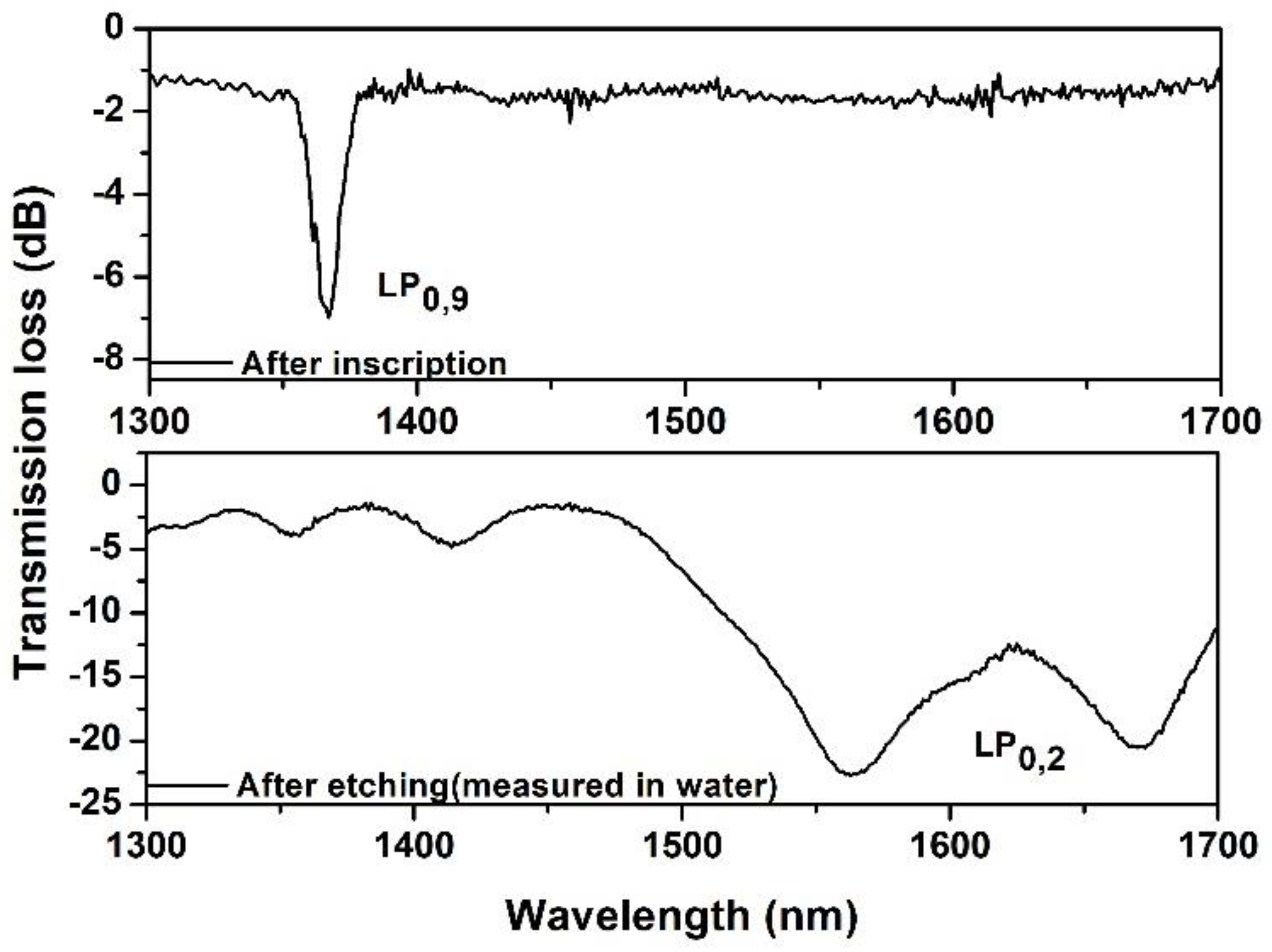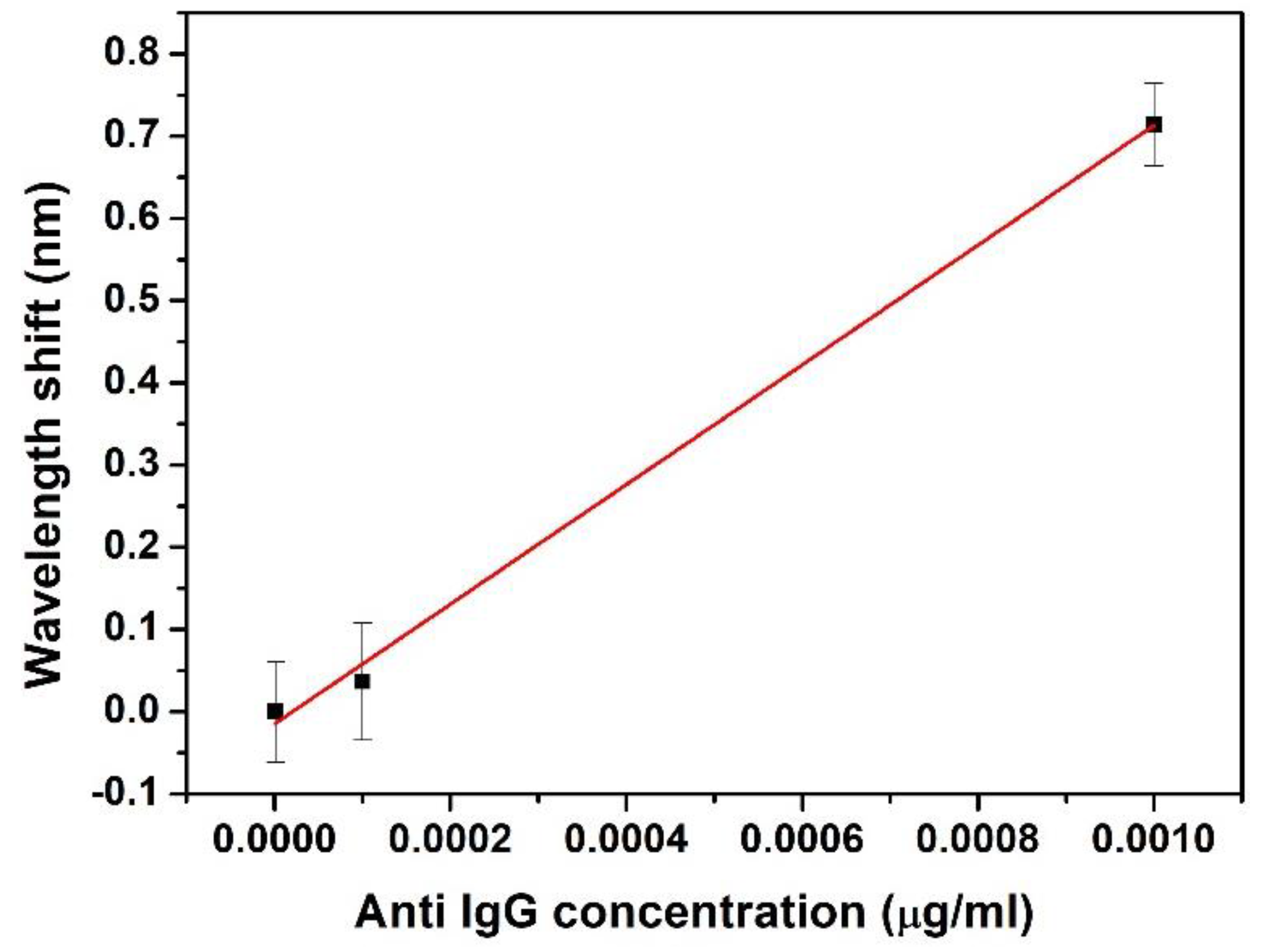Realization of Enhanced Evanescent Field Long Period Fiber Grating near Turn around Point for Label-Free Immunosensing †
Abstract
:1. Introduction
2. Materials and Methods
2.1. Materials
2.2. Methods
3. Results and Discussion
4. Conclusions
Acknowledgments
References
- Chiavaioli, F.; Baldini, F.; Tombelli, S.; Trono, C.; Giannetti, A. Biosensing with optical fiber gratings. Nanophotonics 2017, 6, 663–679. [Google Scholar] [CrossRef]
- Korposh, S.; Lee, S.; James, S. Long Period Grating Based Fibre Optic Chemical Sensors. In Fiber Optic Sensors Current Status and Future Possibilities; Smart Sensors, Measurement and Instrumentation Book Series; Springer: Cham, Switzerland, 2017; Volume 21, pp. 241–267. [Google Scholar]
- James, S.W.; Tatam, R.P. Optical fiber long-period grating sensors: Characteristics and application. Meas. Sci. Technol. 2003, 14, R49–R61. [Google Scholar] [CrossRef]
- Urrutia, A.; Villar, I.D.; Zubiate, P.; Zamarreño, C.R. A comprehensive review of optical fiber refractometers: Toward a standard comparative criterion. Laser Photonics Rev. 2019, 13, 1900094. [Google Scholar] [CrossRef]
- Yang, F.; Chang, T.; Liu, T.; Wu, D.; Du, H.; Liang, J.; Tian, F. Label- free detection of Staphylococcus aureus bacteria using long-period fiber grating with functional polyelectrolyte coatings. Biosens. Bioelectron. 2019, 133, 147–153. [Google Scholar] [CrossRef]
- Esposito, F.; Sansone, L.; Taddei, C.; Campopiano, S.; Giordano, M.; Iadicicco, A. Ultrasensitive biosensor based on long period grating coated with polycarbonate-graphene oxide multilayer. Sens. Actuators B Chem. 2018, 274, 517–526. [Google Scholar] [CrossRef]
- Janczuk-Richter, M.; Piestrzynska, M.; Burnat, D.; Sezemsky, P.; Stranak, V.; Bock, W.J.; Bogdanowicz, R.; Niedziolka-Jonsson, J.; Smietana, M. Optical investigation of electrochemical process using a long-period fiber grating functionalized by indium tin oxide. Sens. Actuators B Chem. 2019, 279, 223–229. [Google Scholar] [CrossRef]
- Patrick, H.J.; Kersey, A.D.; Bucholtz, F. Analysis of the response of long period fiber grating to external index of refraction. J. Lightwave Technol. 1998, 16, 1606–1612. [Google Scholar] [CrossRef]
- Villar, I.D.; Matias, I.R.; Arregui, F.J.; Lalanne, P. Optimization of sensitivity in long period fiber grating with overlay deposition. Opt. Express 2005, 13, 56–69. [Google Scholar] [CrossRef]
- Chiavaioli, F.; Biswas, P.; Trono, C.; Jana, S.; Bandyopadhyay, S.; Basumallick, N.; Giannetti, A.; Tombelli, S.; Bera, S.; Mallick, A.; et al. Sol-gel-based titania-silica thin film overlay for long period fiber grating based biosensors. Anal. Chem. 2015, 87, 12024–12031. [Google Scholar] [CrossRef]
- Pilla, P.; Manzillo, P.F.; Malachovska, V.; Buosciolo, A.; Campopiano, S.; Cutolo, A.; Ambrosio, L.; Giordano, M.; Cusano, A. Long period grating working in transition mode as promising technological platform for label free biosensing. Opt. Exp. 2009, 17, 20039–20050. [Google Scholar] [CrossRef]
- Pilla, P.; Malachovska, V.; Borriello, A.; Buosciolo, A.; Giordano, M.; Ambrosio, L.; Cutolo, A.; Cusano, A. Transition mode long period grating biosensor with functional multilayer coatings. Opt. Exp. 2011, 19, 512–526. [Google Scholar] [CrossRef]
- Shu, X.; Zhang, L.; Bennion, I. Sensitivity characteristics of long-period fiber grating. J. Lightwave Technol. 2002, 20, 255–266. [Google Scholar]
- Biswas, P.; Basumallick, N.; Bandyopadhyay, S.; Dasgupta, K.; Ghosh, A.; Bandyopadhyay, S. Sensitivity enhancement of turn-around-point long period grating by tuning initial coupling condition. IEEE Sens. J. 2015, 15, 1240–1245. [Google Scholar] [CrossRef]
- Chiang, K.S.; Liu, Y.; Ng, M.N.; Dong, X. Analysis of etched long-period fiber grating and its response to external refractive index. Electron. Lett. 2000, 36, 966–967. [Google Scholar] [CrossRef]
- Śmietana, M.; Koba, M.; Mikulic, P.; Bock, W.J. Measurements of reactive ion etching process effect using long-period fiber gratings. Opt. Exp. 2014, 22, 5986–5994. [Google Scholar] [CrossRef]
- Zou, F.; Liu, Y.; Mou, C.; Zhu, S. Optimization of refractive index sensitivity in nano-film coated long-period fiber grating near dispersion turning point. J. Lightwave Technol. 2019. [Google Scholar] [CrossRef]
- Villar, I.D.; Cruz, J.L.; Socorro, A.B.; Corres, J.M.; Matias, I.R. Sensitivity optimization with cladding-etched long period fiber gratings at dispersion turning point. Opt. Exp. 2016, 24, 17680–17685. [Google Scholar] [CrossRef]
- Villar, I.D. Ultrahigh-sensitivity sensors based on thin-film coated long period grating with reduced diameter, in transition mode and near the dispersion turning point. Opt. Exp. 2015, 23, 8389–8398. [Google Scholar] [CrossRef]
- Piestrzyńska, M.; Dominik, M.; Kosiel, K.; Janczuk-Richter, M.; Szot-Karpińska, K.; Brzozowska, E.; Shao, L.; Niedziółka-Jonsson, J.; Bock, W.J.; Śmietana, M. Ultrasensitive tantalum oxide nano-coated long-period grating for detection of various biological targets. Biosens. Bioelectron. 2019, 133, 8–15. [Google Scholar] [CrossRef]
- Śmietana, M.; Koba, M.; Mikulic, P.; Bock, W.J. Towards refractive index sensitivity of long period gratings at level of tens of µm per refractive index unit: Fiber cladding etching and nano-coating deposition. Opt. Exp. 2016, 24, 11897–11904. [Google Scholar] [CrossRef]
- Smietana, M.; Koba, M.; Mikulic, P.; Bock, W.J. Combined plasma-based fiber etching and diamond-like carbon nanooverlay deposition for enhancing sensitivity of long-period grating. J. Lightwave Technol. 2016, 34, 4615–4619. [Google Scholar] [CrossRef]
- Dey, T.K.; Biswas, P.; Bandyopadhyay, S.; Basumallick, N.; Bandyopadhyay, K.D.S. Sensitivity analysis of a dispersed clad mode to surrounding refractive index. In Proceedings of the 2015 International Conference on Microwave and Photonics (ICMAP), Dhanbad, India, 11–13 December 2015. [Google Scholar] [CrossRef]
- Dey, T.K.; Tombelli, S.; Biswas, P.; Giannetti, A.; Basumallick, N.; Baldini, F.; Bandyopadhyay, S.; Trono, C. Analysis of the Lowest Order Cladding Mode of Long Period Fiber Gratings near Turn Around Point. J. Lightwave Technol. 2020. [Google Scholar] [CrossRef]
- Barbosa, E.A.; Silva, D.M.; Preto, A.O.; Verzini, R. Design, construction, and performance of a real-time holographic refractometry prototype for liquid analysis. Rev. Sci. Instrum. 2011, 82, 013103. [Google Scholar] [CrossRef] [PubMed]



Publisher’s Note: MDPI stays neutral with regard to jurisdictional claims in published maps and institutional affiliations. |
© 2020 by the authors. Licensee MDPI, Basel, Switzerland. This article is an open access article distributed under the terms and conditions of the Creative Commons Attribution (CC BY) license (https://creativecommons.org/licenses/by/4.0/).
Share and Cite
Dey, T.K.; Tombelli, S.; Biswas, P.; Giannetti, A.; Basumallick, N.; Baldini, F.; Bandyopadhyay, S.; Trono, C. Realization of Enhanced Evanescent Field Long Period Fiber Grating near Turn around Point for Label-Free Immunosensing. Proceedings 2020, 60, 9. https://doi.org/10.3390/IECB2020-07063
Dey TK, Tombelli S, Biswas P, Giannetti A, Basumallick N, Baldini F, Bandyopadhyay S, Trono C. Realization of Enhanced Evanescent Field Long Period Fiber Grating near Turn around Point for Label-Free Immunosensing. Proceedings. 2020; 60(1):9. https://doi.org/10.3390/IECB2020-07063
Chicago/Turabian StyleDey, Tanoy Kumar, Sara Tombelli, Palas Biswas, Ambra Giannetti, Nandini Basumallick, Francesco Baldini, Somnath Bandyopadhyay, and Cosimo Trono. 2020. "Realization of Enhanced Evanescent Field Long Period Fiber Grating near Turn around Point for Label-Free Immunosensing" Proceedings 60, no. 1: 9. https://doi.org/10.3390/IECB2020-07063
APA StyleDey, T. K., Tombelli, S., Biswas, P., Giannetti, A., Basumallick, N., Baldini, F., Bandyopadhyay, S., & Trono, C. (2020). Realization of Enhanced Evanescent Field Long Period Fiber Grating near Turn around Point for Label-Free Immunosensing. Proceedings, 60(1), 9. https://doi.org/10.3390/IECB2020-07063








